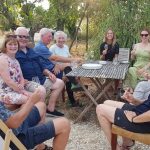Biodiversity Everywhere – farms, gardens, parks
COP15 on biodiversity closed hot on the heels of COP26 on climate change. COPs have not proven to create massive change but all of us changing our ways does – rewilding our gardens, our lawns, our farms , and our laws.
What is biodiversity?
But what is Biodiversity? Biodiversity means biological diversity in an environment, as indicated by numbers of different species of plants, insects, and animals. Sometimes people are confused about the terms ‘biologique’ which means organic in French (a term that can only be used for certified organic products), biodynamic (a way of farming that is ‘organic +’ see our online organic and biodynamic trail for more details, and biodiversity.
Unlike the other two terms, biodiversity is not a certification, but it is a valuable component of a healthy farm, a key element of regenerative agriculture, and something that can be encouraged on conventional, organic, and biodynamic farms, in gardens, in parks, everywhere.
Why is it important?
We are only beginning to understand the importance of biodiversity, at a time when we are losing biodiversity as an accelerating pace. The Intergovernmental Science-Policy Platform on Biodiversity and Ecosystem Services (IPBES) 2019 Global Assessment Report on Biodiversity and Ecosystem Services estimated that 1 in 4 species was at risk of extinction due to pollution, loss of habitat, and climate change. Ecosystems are like a house of cards, if one goes, it impacts many others and accelerates more loss and potential collapse of the entire system.
COP15 in Montreal, Canada in December 2022 set the objective of protecting 30% of land and sea by 2030. Its a simple headline getter. Perhaps it will help to progress biodiversity. But all land and sea should be covered by law against ecocide for our lives depend on it (find out more about ‘stop ecocide’ law). Each of us can play our part, not wait for a COP or a politician to solve this existential problem or its companion Climate Crisis. Dorothy Ries Faison is an American artist based in the Dordogne who chronicles the climate crisis and transforming lawns into biodiversity centres with a lawnboat. Mary Reynolds is an Irish landscape artist turned biodiversity guru, her insta profile say ‘Ex-garden designer, but everything must change’ . She is reimagining and rebuilding relationships with nature through her movement Letsbuildanark and its associated book (see list at end of this article). We and farmers like us are making changes on our farms.
Biodiversity at Feely farm
A variety of plants (plant biodiversity) growing in the vineyard brings a variety of insects including the beneficial ones. Feely farm has 28% set aside for wild areas including hedgerows, groves, forests, and prairies. We encourage wild plants to grow between our vine rows, and ivy and trees within the rows, creating plant biodiversity that brings insect, bird, and mammal biodiversity. This set aside contributes benefits.
Benefits of biodiversity
This is far from an exhaustive list but rather a few direct impacts that we have seen in Feely vineyard.
- Through insect biodiversity we have large populations of good insects like ladybirds, Typhlodromus, and common green lacewings, that keep those we don’t want, like aphids and spider mites, under control. This means we avoid insecticides. This concept goes beyond low level plants and grasses to include trees in the vineyard and hedgerows around the edges of the vineyard.
- In 2014 after we changed to hand picking all our grapes, Sean encouraged ivy to grow every 20 metres or so, ideally on a trellis post, to feed pollinators. Ivy flowers in late autumn, offering much needed pollen for bees and other pollianators as we descend into the darkest days of the year.
- Ivy and trees in the vineyard offer benefits beyond pollen. For years we wondered why we didn’t have a problem with grape worm. Bats are our ally. Bats can eat their body weight of the European grapevine moth in a night. They solve the grape worm issue for us. But bats will only fly about 30 metres into a monoculture with no relief. To go further they need navigation points, what our ivy and trees in the vineyard provide. What Sean started for bees is great for bats too.
- An oak tree with ivy growing on it will host double the biodiversity than the same oak tree without ivy (an agroforestry specialist estimated about 250 species on a no-ivy oak and about 500 on one with ivy). Hedgerows, forests, and layers in the vineyard, like the ivy and trees we are training along the trellising, offer bats, other mammals, birds, and insects, habitats, or places to live. Ivy is a mega biodiversity booster.
Fungi biodiversity
Beautiful wild orchids flower each April and May in Feely vineyard. They are a sign of a healthy living soil. Orchids are dependent on mycorrhizae, a special fungus that develops on the root systems of 95% of plants tested to date and helps them access nutrients in the soil. This mutually beneficial relationship came about more than 400 million years ago. Research shows that mycorrhizal networks transport carbon, phosphorus, nitrogen, water, and defence compounds – compounds that combat attack by something, from plant to plant. They are especially beneficial for plants in nutrient poor soils. The best wine grapes are grown on relatively poor soil, so it is particularly relevant for us winegrowers. These magic mushrooms will not develop in chemically farmed soil because of systemic fungicides. Wild orchids appeared after three years of organic farming at Chateau Feely, an indicator that the farm was clear of the systemic fungicides that had been used before we arrived in 2005. Systemic fungicides are bad for us, they can be carcinogenic (cancer causing) and nervous system disruptors. They are ‘systemic’, that means they go inside the plant and inside the fruit and can’t be washed off.
What can you do to encourage biodiversity?
Some tips I gathered about how to encourage farm biodiversity on a course winter 2022 and many of the concepts can be applied to a garden too.
Here are some of the ideas that are simple and easy:
- Leave medium sized stacks of branches in a few places as a home for insects and small mammals.
- If you have a shaded wooded area leave logs to decompose as they offer fungi, moss, insects, and others a home.
- If you have the space, select a part of your garden to leave wild.
- For borders, if you have space, go for local multi-species hedgerows rather than walls or fences. Try to link your hedgerows to others so you create biodiversity corridors.
- You could also leave some grassy areas unmown, perhaps use the mower to create a path to a small section where you particularly want mown lawn and leave the rest to nature. It saves mower energy and encourages life in your garden.
- Avoid insecticides and herbicides for your health and for the inhabitants of your garden.
- Include a water source, even a small container or birdbath, is very beneficial.
If all the monoculture lawn gardens in the world were transformed into havens of biodiversity a major bulwark against biodiversity loss would be created.
Conclusion
Every farm or garden transformed into a biodiversity haven makes a difference. Every change that you make to offer a haven for fellow inhabitants of planet earth is good for them and for us.
Have you had success with biodiversity in your garden? Do you have any ideas to add to this list? Let us know in the comments below.
Would you be interested in reading books like these with me in a book club? Let me know in the comments below.
Read Caro Feely’s finalist entry into the Jancis Robinson wine writing competition on Regeneration.
See below for books to read to widen your knowledge on this subject. Do you have other suggestions that should be on this list? Please let us know in the comments below.
Books to read
I am keen to reread this book and look forward to revisiting it with my soon to be announced book club. It is filled with joy, wisdom and gentle strong messages.
We Are the ARK: Returning Our Gardens to Their True Nature Through Acts of Restorative Kindness
by Mary Reynolds, high recommend following her instagram for inspiration too.
THE SIXTH EXTINCTION: AN UNNATURAL HISTORY
In The Sixth Extinction: An Unnatural History – Elizabeth Kolbert takes us on a journey to understand why there is a mass extinction on the go.
It’s not just about climate crisis, it is also about hyper global mobility – another reason Corona virus was able to go global as fast as it did.
Elizabeth Kolbert has followed it with another book Under a White Sky: The Nature of the Future
Its on my wishlist.
WILDING: RETURNING NATURE TO OUR FARM
Wilding: Returning Nature to Our Farm by Isabella Tree has experienced massive success – it tells the story of her and her husband’s transformation of their massive farm from an intensively farmed estate that was losing money to a conservation haven. While the jury is still out on how this new model can be made to work economically without ongoing subsidies – its clear that the other model was failing and this one is far kinder to the land and the wider environment.
Come and learn more about wine, organic farming and yoga, with a visit to Chateau Feely in South West France ; stay or do a multi day course or multi day tour. Find out more about our way of farming with organic and biodynamic practices on the Feely organic and biodynamic online trail. You can read about the story of this organic farm – Caro Feely books.
Join the mailing list to receive a seasonal newsletter, events, wine pairing, recipes and more info on this topic at the bottom right of this page.















